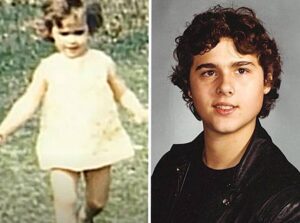Today, transgenderism dominates political discourse and popular culture.
The once relatively obscure medical condition is found almost everywhere – ubiquitous in print, advertising and all modern entertainment.
It has found a home in TikTok communities dominated by teenagers and young people. In schools and across the education system, “gender ideology” is taught to children as young as five. Teachers insist that sex is not immutable and gender is fluid.
Its growing representation has had a polarizing effect like few issues ever have.
But transgenderism has not always been mainstream. As it has grown in popularity, we have reached what can only be considered the proverbial red line: the transing of children.
This line is crossed daily around the world. Adolescent children are subject to hormone treatment and even surgical sex reassignment (SRS). In truth, these “treatments” amount to little more than mutilation, irrevocably changing the lives of young people who are in the midst of critical physical and mental development.
We once snickered at overprotective “helicopter parents” of the ’90s and 2000s. Sadly, we now see the opposite in action – today, parents are willing to medicalize their children for life, often to satisfy their own pathologies.
What few understand is how we arrived at this intersection. Over the decades, adults have undergone gender reassignment in one form or another. However, in all human history, not one society until now has taken the steps – and with glee I might add – to both normalize and promote sex reassignment in children.
Knowing this, one salient question persists: how did we get here?
The path to sex reassignment
Gender reassignment is not as new a phenomenon as you might believe.
The practice has been a subject of controversy since the early 1900s. In America, it wasn’t until the 1960s, when these surgeries were conducted at John’s Hopkins University by psychologist John Money and surgeon Claude Migeon, that the foundation for today’s gender ideology started to take shape.
From the very beginning, sex reassignment was divisive, frowned upon. In hindsight, it should be seen as a cautionary tale that the world has ignored at its own peril.
In the early 1900s and in response to the illegality of homosexuality under German law, a young Jewish doctor named Magnus Hirschfeld founded the Institute of Sexual Research – a place where sex reassignment surgeries would be tested for the first time.

Several decades earlier, the now infamous Paragraph 175 was established, criminalizing sex between men and making it punishable by law. Surprisingly, this law wouldn’t be repealed until 1994, effectively putting an end to a century of persecution of male homosexuals in Germany.
Due to Paragraph 175 and the prevailing negative attitudes towards homosexuality in the 1900s, gay men had no choice than to hide their proclivity. This created an underground Berlin of sorts that thrived for some time. Magnus Hirschfeld was one of its leaders.
Hirschfeld, himself a gay man, disagreed with the popular opinion of the time that homosexuality was a mental illness. After receiving a letter from a man who’d taken his own life out of shame for his same-sex attraction, a deeply affected Hirschfeld committed himself to the study of sexual health, specializing in homosexuality.
In 1897, he founded the Scientific Humanitarian Committee, an organization with members from around the world that promoted sexuality research. It was created, in part, with the hopes of abolishing Paragraph 175 from the German legal code.
During this time, Hirschfeld also developed his own theory of “sexual intermediaries” – what would be recognized today as “non-binary”. He believed this should be considered a “third sex”, known as geschlecht in German.
In 1910, he coined the term “transvestite” and by the late 1920s, Hirschfeld’s Institute for Sexual Research was performing the world’s first sex reassignment surgeries.
The first of these operations took place in 1926. Dr Felix Abraham performed a mastectomy on a trans-identified female. Four years later, in 1930, Abraham performed the first penectomy on his “domestic servant” called Dora.
Perhaps the most well-known patient to attend the Institute of Sexual Research was Danish painter Lili Elbe, whose first surgery was carried out at the clinic. Elbe underwent four surgeries total, including a vaginoplasty. The last of which – a womb transplant – proved to be fatal.
Over the years, the Institute gained a level of notoriety.
It was considered impressive that it was not only able to conduct such research, but that it managed to exist independently for 13 years until the Nazis rose to power.
In 1933, Hirschfeld’s luck ran out. The property was raided and destroyed by Nazi soldiers. They ransacked the Institute’s library, burning books and years of research in the street for all to see. This was, of course, filmed and later used as video propaganda. Fortunately for Hirschfeld, he was out of the country at the time. He would remain in exile, living in France until his death.
In America, transsexualism hadn’t received the same level of attention. The disorder continued to be obscure and uncommon. That changed in 1952 when Christine Jorgensen, a WWII veteran, returned home from Denmark.

The New York Daily News ran a piece, “Ex-GI becomes blonde beauty: operations transform Bronx Youth”. It detailed how Jorgensen had sought sex reassignment while abroad. The news story catapulted Jorgensen to fame, bringing SRS to the attention of the American public. It also resulted in a 1970 Hollywood film about Jorgensen’s life.
In walks gender ideology
Interestingly, around the same time, another figure was emerging in the world of gender and sex reassignment.
John Money, a New Zealand sexologist and psychologist, received his PhD from Harvard in 1952. He went on to become a professor of Medical Psychology and Pediatrics at Johns Hopkins University. While there, his work centered on a theory – one that is at the core of transgender ideology.
Today, he is understood as the godfather of the modern transgender movement. Some also hold him squarely responsible for the gender theory that has infected young people in the West.
Money, like other gender ideologues, insisted that gender is a social construct, one that is fluid and ever-changing.
You may be asking yourself, how could Money possibly test this theory? He’d need test subjects – newborn children that could be “socialized” as the other sex. And as unlikely as it may seem, that is precisely what Money did with a young Canadian boy, David Reimer.

At around seven months old, David suffered a catastrophic injury to his penis after a failed circumcision. Not knowing what else to do, David’s parents took him to John’s Hopkins hospital in Baltimore, Maryland to see John Money.
In this child, John Money saw an opportunity to test his theory and convinced David’s parents to allow their son to undergo a surgical sex change.
This would be the first sex reassignment surgery ever conducted on an otherwise normal, healthy child. The process entailed clinical castration, followed by 12 years of hormone therapy, along with social and mental conditioning to convince David he was a girl.
One extraordinary aspect of this story is that David had an identical twin brother, Brian, and this provided Money a “matched control.”
This added an odd sort of credibility to the research, one which fascinated the wider medical community. Ultimately, the experiment was widely celebrated in the literature as an unequivocal triumph.
This perception of success didn’t just reside in medical literature. It also helped rewrite text in the mediums of psychology and sociology, and cast doubt on the then-common belief that masculine and feminine features are immutable characteristics, coded in genes.
The reality was considerably more grim. It would be 22 years later, in 1997, when the world learned the truth of the David Reimer experiment and its outcome.
However, this information came too late. The ideological seeds of gender ideology had long been planted, watered and grown by academia and the media.
Doctors Milton Diamond and Keith Sigmundson published a document in the Archives of Pediatrics and Adolescent Medicine that laid bare the abject failure of Money’s experiment.
David never felt like a girl. He never accepted life as a girl. Although he eventually de-transitioned, the damage was done.
When asked by Diamond and Signumdson why he went along with the experiment, David answered simply that he wanted to please his parents. Sadly, in 2004 and at the age of 38, David committed suicide with a single gunshot to the head in Winnipeg, Canada.
The mental strain of public attention and his own personal struggles proved too much.
We know today this is not an isolated incident. Many individuals have taken their own lives after attempting gender reassignment, before soon realizing they wanted to revert back to their biological sex.
Transgender activists often point to Money’s experiment with David Reimer as proof that gender identity supersedes born sex. However, they fail to mention that David rejected this conditioning. He never felt female. And the trauma Money inflicted on him cost David not only is life, but a potential life of opportunity.
To make matters worse, not only was the godfather of the modern transgender movement a child abuser, he was also at the very least a pedophile sympathizer.
If experimentation on children wasn’t bad enough, Money had an even darker side that is little discussed in the lionizing profiles of him written in transgender lore. Money believed that pedophilia was something, that if practiced “properly”, would suffer a child “no harm.”
In 1991, Money was quoted by the pro-pedophile magazine, Paidika, having said:
“If I were to see the case of a boy aged ten or eleven who’s intensely erotically attracted toward a man in his twenties or thirties, if the relationship is totally mutual, and the bonding is genuinely totally mutual, then I would not call it pathological in any way.”
In his quote he references adolescent boys being able to consent to relationships with men in their twenties. This line of thinking is often used to argue that a child can understand and consent to irreversible surgery and hormone treatment.
This argument isn’t steeped in any logical reasoning or scientific fact. And it largely drives what we are seeing in action today: the medicalization of children.
And then they made children life-long big pharma customers
The shift from consenting adults doing with their body whatever they choose to the aggressive push of gender ideology onto young people has been slow rolling for decades.
The trouble today is that any legitimate criticism of this push is met with vitriol. The movement has become increasingly militarized and extremely effective at silencing critics.
Worse still is the reality that doctors and medical professionals are failing at the most basic level – explaining to parents and young people the long-term consequences and effects of transgender surgeries and interventions.
Gender reassignment treatments for children, including hormone therapy and surgeries, have become increasingly common in recent years. Many medical professionals and institutions have taken a flippant approach to these treatments, prioritizing the validation of a child’s transgender identity over properly informing them and their parents of the potential risks and consequences.
Puberty blockers, for example, have been prescribed to children and teens in the hopes of “halting” puberty. However, these drugs have not been approved by the FDA for this purpose and have been shown to result in irreversible physical changes, such as stunted pubertal development, halted menstruation, and infertility.
Lupron, one such puberty blocker, has not been shown to be safe for children and can interfere with brain development, potentially suppressing peak IQ and future cognitive capacities.
Despite these risks, institutions like the World Professional Association for Transgender Health (WPATH) have claimed that the effects of these treatments are reversible, while simultaneously admitting that the long-term effects can only be determined when the earliest treated patients reach the appropriate age.
This is explicit admission that they simply do not know because this is so new we must await the passage of time to find out. One thing they do know is that when you halt a child’s pubertal development, you are essentially freezing their sexual organ into a childlike state.
These treatments can lead to a “disease state” that is not unlike the effects of a pituitary tumor, halting normal and healthy biological development in a child.
The use of gender-affirming surgeries on minors as young as 15 years old is also a disturbing trend. In some states, a 15-year-old girl who feels like she is in the wrong body can have her breasts removed via a mastectomy, while vaginoplasty surgeries have been performed on youth as young as 16 years old.
This kind of intervention is nothing short of child mutilation and exploitation, and it is unconscionable that parents are allowed to consent to such treatments for their children.
It is important to note that these are experimental procedures on vulnerable young people, and there is no reliable long-term data on their consequences.
The sad, understated reality is that as these surgeries become more common, the number of detransitioners has also increased. These are individuals who transitioned in one way or another, but eventually reverted back to their original sex.
Thousands of case reports by individuals who realized that hormone therapy or surgery was a mistake have surfaced. Many have indicated that improper mental health support and a lack of informed consent landed them where they are. In short, doctors and physicians failed in one of their most basic duties: do no harm.
The reality is that gender conversion is big business. And getting children in the doors of gender clinics creates a life-long Big Pharma customer. Pediatric versions of Lupron are much more expensive than the adult version of the same drug.
We will never really know if the transgender movement was started with good or bad intentions. If the early surgeries and clinics were really acting in the best interest of patients, or if they were places of experimentation and perverse fascination.
What we do know is that the more mainstream transgenderism has become, the more our children are being affected. The longer they are affected, the greater these problems will be down the road.
When you get to the heart of it, there are few ways a rational person can justify the life-long medicalization of children.







